Chaos in Essentially Singular 3D Dynamical Systems with Two Quadratic Nonlinearities
Abstract
A new class of 3D autonomous quadratic systems, the dynamics of which demonstrate a chaotic behavior, is found. This class is a generalization of the well-known class of Lorenz-like systems. The existence conditions of limit cycles in systems of the mentioned class are found. In addition, it is shown that, with the change of the appropriate parameters of systems of the indicated class, chaotic attractors different from the Lorenz attractor can be generated (these attractors are the result of the cascade of limit cycles bifurcations). Examples are given.
1. Introduction
Chaos is a very interesting nonlinear phenomenon, which has been intensively studied in the last four decades. Many potential applications have come true in secure communication, laser and biological systems, hydrodynamics and chemical technologies, and other areas (see, e.g., [1, 2] and many references cited therein).
Notice that interest in the study of the chaotic systems increases only (see, e.g., [3–19]). We will specify a few scientific directions, in which application of methods of chaotic dynamics appeared most effective.
In the scientific literature, chaotic economic systems have got much attention because their complex dynamic behaviors cannot be described by traditional models. Recently, a few researches on the usage of these systems in cryptographic algorithms have been conducted. A new image encryption algorithm based on a chaotic economic map is proposed. Implementation of the proposed algorithm on a plain image based on the chaotic map is performed [3].
The paper [4] investigates the multipulse heteroclinic bifurcations and chaotic dynamics of a laminated composite piezoelectric rectangular plate by using an extended Melnikov method in the resonant case.
A chaotic system arising from double-diffusive convection in a fluid layer is investigated in [5] based on the theory of dynamical systems. A five-dimensional model of chaotic systems is obtained using the Galerkin truncated approximation. The results showed that the transition from steady convection to chaos via the Hopf bifurcation produced a limit cycle, which may be associated with a homoclinic explosion at a slightly subcritical value of the Rayleigh number.
The paper [6] investigates the problem of two kinds of function projective synchronization of financial chaotic system with definite integration scaling function, which are not fully considered in the existing researches. In this paper, the following two questions (unlike previous methods) are investigated: (1) two kinds of the definite integration scaling function projective synchronization are given and (2) the upper and lower limit of the definite integral scaling function are the bound dynamical systems.
In this connection, the important problem is the establishment of theoretical results, where it is possible to extend the wide classes of the dynamical systems. One of such classes is the class of 3D quadratic systems.
Vast scientific literature is devoted to researches of different types of systems of this class. For instance, 3-scroll and 4-scroll chaotic attractors were investigated in [7]. New existence conditions of heteroclinic and homoclinic orbits were found in [8–10]. New three-wing and four-wing chaotic attractors were opened in [11–14]. The article [15] summarizes investigations of quadratic dynamical systems, which are indicated in [7–14].
Another interesting domain of nonlinear dynamics is the control by the chaotic systems. Novel controllers for stabilization and tracking of chaotic and hyperchaotic Lorenz systems using extended backstepping techniques were proposed in [16]. Based on the proposed approach, the generalized weighted controllers were designed to control the chaotic behavior as well as achieve synchronization in chaotic and hyperchaotic Lorenz systems [16].
System (1) is a three-dimensional autonomous system with only two quadratic terms in its nonlinearity, which is very simple in the algebraic structure and yet is fairly complex in dynamical behaviors. The observation of these two seemingly contradictory aspects of the Lorenz system thereby triggered a great deal of interest from the scientific community to seek closely related Lorenz-like systems, by different motivations and from various perspectives [15].
The primary purpose, which was pursued by the research program that was begun in this work, is to set communication between algebraic and geometric properties of solutions of system (2).
In spite of the vast researches, which are developed in connection with the dynamics of the Lorenz system, a lot of the unsolved problems yet remain. A strange attractor corresponds to the complex nonperiodic mode of the Lorentz system. The system also generates spatial limit cycles in three-dimensional space. A few papers are devoted to the research of the complex closed trajectories which are also connected to chaos, because a transition to the chaotic behavior is sometimes realized in consequence of bifurcations of periodic trajectories on saddle trajectories. Recently (see [17–19]), a row of results describing the behavior of the Lorenz-like systems appeared. The present article is one of such results.
In conclusion, we explain the name of the article. At first sight, it seems that such systems are simpler than 3D systems in which all three equations are nonlinear. However, the existence of one linear equation in system (2) makes application of the theory of positive (or negative) definite quadratic forms impossible. This definiteness was widely used in [17, 18].
In the present paper, some special cases of system (2) will be considered. Note that in system (1) two nonlinearities exist: there are x · y and x · z. In the system which will be studied below, we also will have two nonlinearities: x · (dyy + dzz) and y · (dyy + dzz), where dy and dz are real numbers such that . In our opinion, this is some generalization of system (1). In addition, in this work, the researches begun in [17, 18] will be continued.
2. Bounded Solutions of Quadratic Dynamical Systems
In [17, 18], conditions of appearance of chaos in system (3) were analyzed. As a result of this analysis, the following theorem (with small corrections by comparison to [16, 17]) was proved.
Let Δ1(cosϕ, sin ϕ) ≡ h11 · h(cosϕ, sin ϕ) − f(cosϕ, sin ϕ) · g(cosϕ, sin ϕ), Δ2(cosϕ, sin ϕ) ≡ f22(cosϕ, sin ϕ) · g12(cosϕ, sin ϕ), and be the bounded functions.
Theorem 1 (see [17], [18].)Let h11 < 0. Suppose also that for system (10) the following conditions are fulfilled:
- (i)
Δ2(u, v) is a nonsingular form of the variables u ≡ cosϕ and v ≡ sin ϕ.
- (ii)
Either Δ1(cosϕ, sin ϕ) is a negative constant or Δ1(cosϕ, sin ϕ) is a periodic nonpositive function or Δ1(cosϕ, sin ϕ) is a periodic alternating in sign on (−∞, ∞) function.
- (iii)
Δ2(cosϕ, sin ϕ) and Δ3(cosϕ, sin ϕ) are periodic nonpositive functions.
Suppose that the condition
Then, in system (9) (and system (3)), there are chaotic dynamics.
3. Definition of Essentially Singular 3D Dynamical Systems
The general definition of the singular system was given in [19]. In the present paper, we are restricted by a narrower definition.
Remember that a scalar polynomial f(A, T1, T2) is called an invariant of weight l of the group , if and ∀(A, T1, T2); we have f(S∘(A, T1, T2)) = (det S) l × f(A, T1, T2), where l ≥ 0 is some integer.
In system (13), we replace the variable y by the variable ρ. Now, we can replace the coefficients of system (13) by appropriate coefficients of system (10). (In this case, the invariants J2 and D will be the functions of the variable ϕ: D(cosϕ, sin ϕ), J2(cosϕ, sin ϕ).)
Let u ≡ cosϕ and v ≡ sin ϕ.
Definition 2 (see [19].)System (3) is called essentially singular if for arbitrary real number ϕ the conditions D(u, v) ≡ D(cos ϕ, sin ϕ) ≤ 0 and J2(u, v) ≡ J2(cos ϕ, sin ϕ) ≤ 0 are fulfilled. In addition, there exist the numbers ϕi such that D(cos ϕi, sin ϕi) = J2(cos ϕi, sin ϕi) = 0, i = 1,2, ….
4. Lorenz-Like Systems
The direct calculations of the invariants D(cosϕ, sin ϕ) and J2(cosϕ, sin ϕ) of system (19) show that J2(cosϕ, sin ϕ) = −k3 · (cosϕ) 4 · (a22cosϕ + a23 sin ϕ) 4 and D(cosϕ, sin ϕ) = 4J2(cosϕ, sin ϕ). Thus, we have D(cosϕi, sin ϕi) = J2(cosϕi, sin ϕi) = 0 at ϕi = π/2 + 2π · i or ϕi = −arctan(a22/a23) + π · i, i = 0,1, 2, …, and it is clear that system (19) is essentially singular.
For this system, we have Δ2(cosϕ, sin ϕ) = −k(cosϕ · (a22cosϕ + a23 sin ϕ)) 2 ≤ 0, Δ3(cosϕ, sin ϕ) = 4Δ2(cosϕ, sin ϕ) = −4k(cosϕ · (a22cosϕ + a23 sin ϕ)) 2 ≤ 0. Thus, conditions (i)–(iii) of Theorem 1 are fulfilled.
Theorem 3. Let the equilibrium point (0,0, 0) of system (19) be saddle. Suppose also that for this system the following conditions are valid:
- (i)
h11 < 0, h21 = h31 = 0.
- (ii)
.
- (iii)
There exists a finite limit
() - (iv)
.
Then, all solutions of system (19) are bounded.
Proof. Construct the two following quadratic forms:
Introduce the designations
Compute the eigenvalues of the matrices F and G. By λmin(F) and λmax(H) (λmin(G) and λmax(G)), denote minimal and maximal eigenvalues of the matrix F (the matrix G). Then, we have
Since the point (0,0, 0) is saddle, then det H ≠ 0. Besides, in order for condition (22) to be satisfied, it is necessary that the form g(u, v) was negative definite. In this case, we can consider the following two possibilities:
For research of system (20), we use the known in theory of differential equations Comparison Principle (see [17, 18]). Then, with the help of inequalities (26) and (27), we get instead of system (20) the following system:
By virtue of condition (22) at t → ∞, system (28) can be transformed to the following system with periodic coefficients:
Now, we will consider that for some values of parameters system (29) has a periodic solution. (This means that systems (19) and (20) have also the periodic solutions.)
Suppose that the number tm ≥ 0 satisfies the conditions ptm = pt0 + mπ and the number cos (ptm)(a22cos (ptm) + a23 sin (ptm)) ≠ 0, where m = 0,1, 2, ….
Further, we will consider the solutions of system (29) in a small neighborhood of the point tm: , m = 0,1, 2, …. With initial conditions xm0, ρm0 for system (29), the solutions of system (28) in the point tm are appointed.
Suppose that the time t0 also satisfies the condition
If we will take into consideration formula (32), the second equation of system (29) can be rewritten as
Let
In our case, we can introduce the function
We take advantage of the known Cauchy inequality: ; here, 〈w1, w2〉 is a scalar product of the vectors w1 and w2. Then, it is possible to get the following estimation of the function c(t):
Further, formula (36) can be rewritten as
Above, it was shown that if ∀t ≥ 0 we have b(t) ≥ 0, then . Therefore, we can consider that there exist the positive constants cmin and cmax such that 0 < cmin ≤ c(t) ≤ cmax. Thus, from here and the condition t → ∞, it follows that
Note that if a22 = 0 and k = 1, then system (19) is the classic Lorentz-like system and condition (iv) becomes trivial.
Theorem 4. Let the equilibrium point (0,0, 0) of system (19) be a saddle-focus. Then, under the conditions of Theorem 3 in system (19), there exists a limit cycle.
Proof. Let us calculate Lyapunov’s exponent Λ for a real function f(t) [17, 18]:
We take advantage of the following properties Lyapunov’s exponents:
- (i)
Λ[f1(t) · f2(t)] ≤ Λ[f1(t)] + Λ[f2(t)].
- (ii)
If Λ[f(t)] < 0, then
- (iii)
Λ[f1(t) + f2(t)] ≤ max(Λ[f1(t)], Λ[f2(t)]).
- (iv)
Λ[d · f(t)] = Λ[f(t)] (d ≠ 0).
Taking into account the boundedness of solutions x(t) and ρ(t) of system (28), we have Λ[x] ≤ 0, Λ[ρ] ≤ 0.
We write the first equation of system (28) in the integral form
From here and (i), it follows that Λ(exp(h11t)ξ(t)) ≤ Λ(exp(h11t)) + Λ(ξ(t)) ≤ h11 + 0 = h11 or Λ(exp(h11t)ξ(t)) = −∞. Thus, from (ii) and (iii), it follows that
Further, the function ρ(t) is bounded. Consequently, we get that Λ[ρ(t)] ≤ 0. In addition, from conditions (22), it follows that ϕ(t) → pt. Thus, we have Λ[ϕ(t)] = 0. Since for the limit cycle another Lyapunov exponent is equal to zero, then from here it follows that if Λ[ρ(t)] < 0, then this cycle is stable; if Λ[ρ(t)] = 0, then we have a limit torus.
Theorem 5. Assume that h21 = h31 = 0 and a23 ≠ 0. Suppose also that h11 < 0, ska22 + h22 < 0, and h33 < 0. If the start point , then ∀t > 0 the trajectory (x(t, x0), y(t, y0), z(t, z0)) of system (19) is completely contained in . Thus, the ellipsoid is a basin of system (19).
Proof. Let V(t) = (x(t) + s) 2 + y2(t)/k + z2(t) ≥ 0 be a positive definite function. Then, from system (19), we have
In order for the condition to be fulfilled ∀t ≥ 0, it is necessary that
Let
Let also
It is clear that . This means that trajectories incoming in the ellipsoid at all t ≥ 0 remain in this ellipsoid. Consequently, these trajectories are bounded. The proof is finished.
Notice that Theorem 5 is weaker than Theorems 1, 3, and 4. However, verification of its conditions is constructive.
5. Examples
We will consider that for system (19) the conditions of either Theorem 3 or Theorem 4 are satisfied.
Thus, if h33 det H < 0, then there are three equilibrium points (including the point (0,0, 0)); if h33 det H > 0, then there is only one equilibrium point (0,0, 0). It is easy to check that all equilibrium points will be either saddle-nodes or saddle-focuses or such points, Jacobi’s matrix of which has three positive eigenvalues.
Further, we will study not only situations described in Theorems 3 and 4, but also the cases h21 ≠ 0 and h31 ≠ 0. It is necessary with the changes of the parameters h21 and h31 to realize the cascade of the limit cycle bifurcations at transition from this cycle to the chaotic attractor.
A special case arises, when the condition a22h33 − a23h32 = 0 takes place. In this case, there exists only one unstable equilibrium point (0,0, 0).
6. Conclusion
In the present paper, an attempt to investigate the chaotic dynamics of system (19) was made. This system is a generalization of the known Lorenz system (1). Theorems 3 and 4, by which it is possible not only to build bounded solutions of system (19), but also to predict the existence of spatial limit cycles in this system, were also proved (see Figures 1(a), 2(a)–2(c), and 3(a)–3(c)). As a result, two new chaotic attractors (see Figures 3(d) and 4(f)) were found. Their chaotic behavior is confirmed by Theorem 1 (see Figure 4(d)). (At the same time, Figures 4(c) and 4(e) demonstrate the presence of the limit cycle in system (19) for the specific values of parameters; besides, Figures 4(a) and 4(b) confirm that condition (iv) of Theorem 3 is fulfilled.)
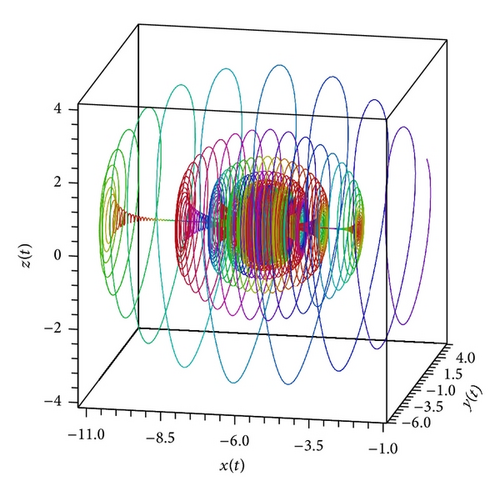
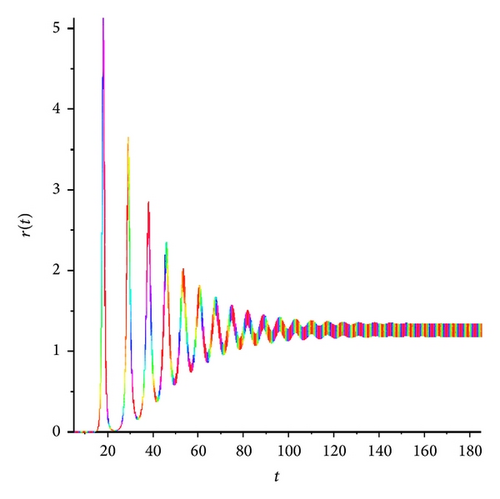
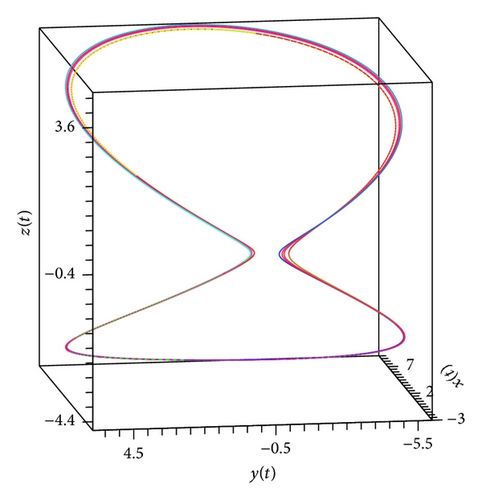
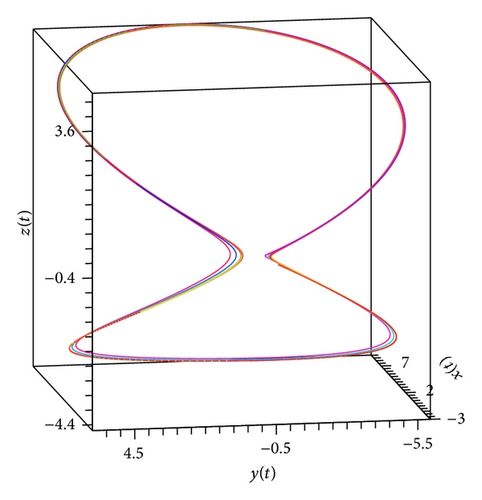
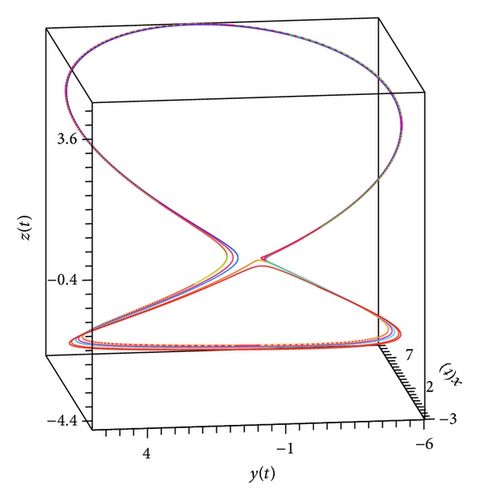
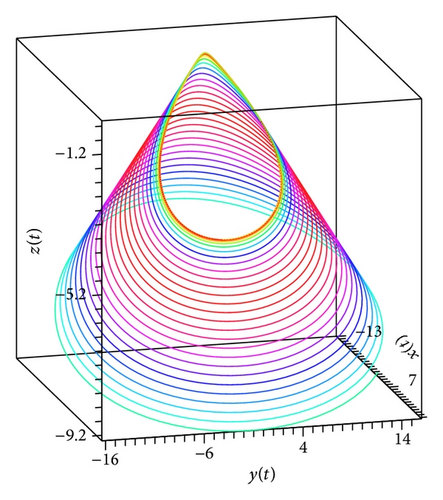
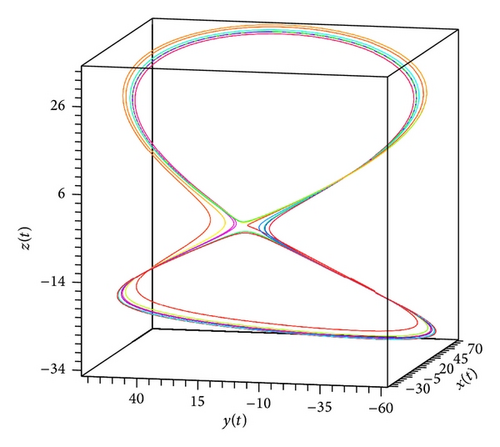
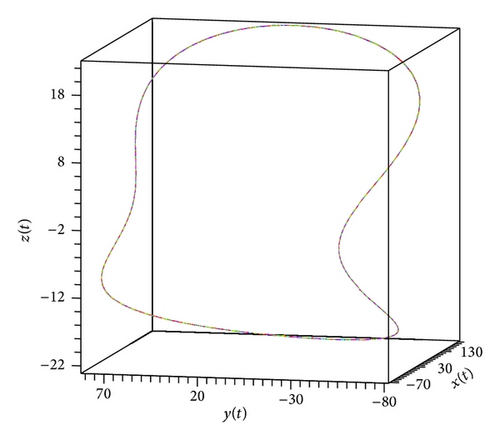
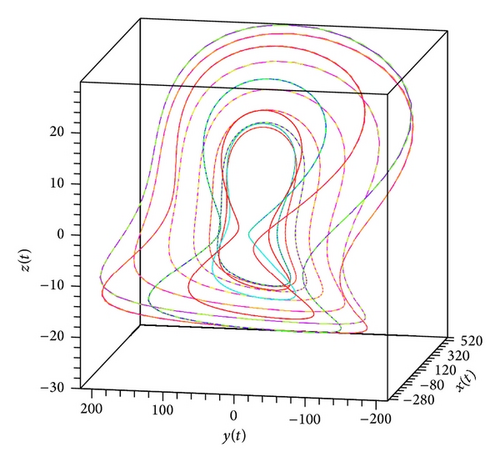
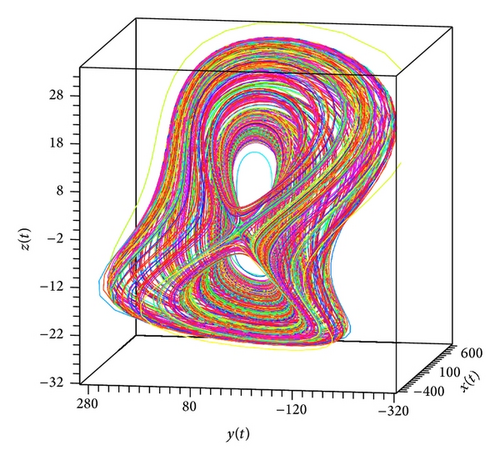
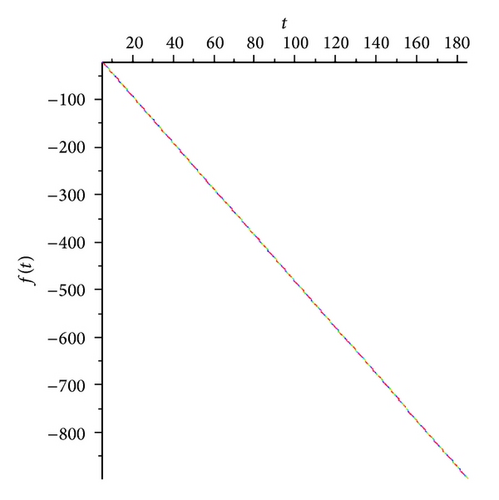
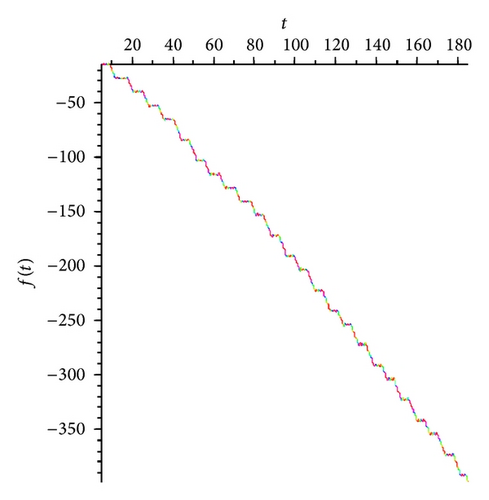

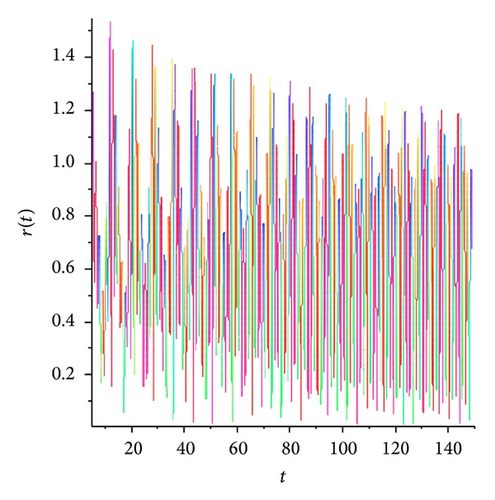
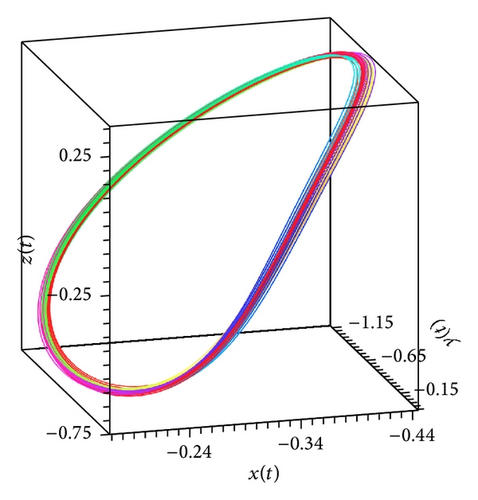
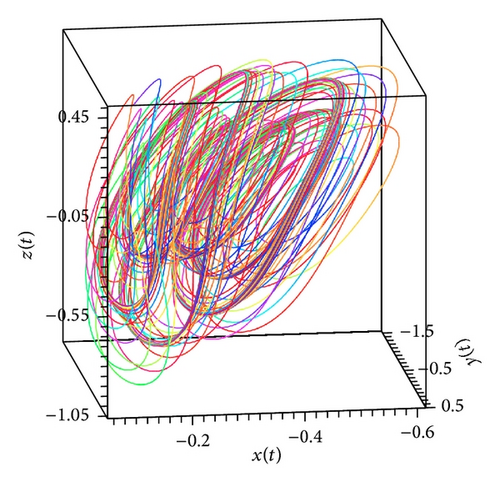
We note that Theorem 1 was the basic result of [17, 18]. In the present work, for the systems of type (19), substantial strengthening of Theorem 1 was got. The point is that condition (12) is not constructible. Nevertheless, if, for the proof of the state of chaos for system (19), we will use new theorems (Theorems 3, 4, and 5), then the verification of condition (12) can be ignored.
In addition, we did not begin to write the value of coefficients of system (19) (different from classic) at which in this system there is the Lorentz attractor. Researches of this attractor in detail are described in numerous articles and books.
Competing Interests
The author declares that are no competing interests regarding the publication of this paper.




